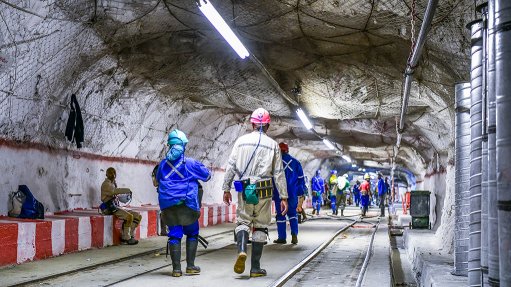
DEPTH OF RESOURCES The SA deep-level mining industry has to modernise if it hopes to access the remaining reserves and resources that lie at increasing depth
South Africa has many “cutting-edge mines” and is a global leader in deep-level mining, says mining industry employers’ organisation Minerals Council South Africa CEO Roger Baxter.
However, he tells Mining Weekly that mining deeper and further away from the shaft presents many challenges.
He highlights safety, efficiencies and cooling in this regard, adding that, as the industry seeks to optimise operations and make them safer, increase the representation of women, upskill employees and provide fulfilling jobs for a new generation of South African miners, it is also seeking to “modernise what it does and how it does it”.
Since embarking on this modernisation journey in 2017, the Minerals Council has established a detailed framework and, through industry collaboration, instituted programmes and projects that seek to modernise the industry through societal and technological innovation, says Baxter.
An important part of these programmes has been the Minerals Council’s establishment and cofunding of the public–private collaborative entity, the Mandela Mining Precinct, alongside the Department of Science and Innovation – which falls under the Higher Education, Science and Technology Ministry.
This partnership is structured on a 2:1 funding basis, whereby the Minerals Council invests R1 for every R2 that the department invests.
“The precinct is an initiative aimed at revitalising mining research, development and innovation in South Africa through research-based programmes, all of which have the potential to impact on deep-level mining,” he highlights.
These programmes include developing advanced orebody knowledge, ensuring the longevity of current mines, mechanised drill and blast, non-explosive rock breaking, real-time information systems, as well as the successful application of technology centred around people.
In an effort to improve health and safety and to ensure production, there is a need to develop far more continuous production through advanced orebody knowledge, which aims to establish a three-dimensional, real-time model that allows for accurate planning, design and scheduling, and promotes confidence in plans.
Baxter points out that some of the project outputs will be rock characterisation for the application of various advanced orebody-knowledge technologies. These technologies will also include incremental improvement techniques and robotic/borehole platforms for remote operation, as well as developing and commercialising disruptive new techniques.
Meanwhile, as many of the existing operations are threatened by decreasing productivity, increasing unit costs and continued safety challenges, Baxter emphasises the need to re-examine all aspects of the mining cycle.
This is particularly important if the South African mining industry aims to achieve zero harm, while ensuring the longevity of current mines programmes.
The mechanised drill and blast programme aims to develop solutions that will lead to an increase in economically feasible gold and platinum group metals orebodies in South Africa through new mining approaches.
“These approaches, which will largely remove people from the rockface, will also improve employee health and safety, increase productivity and reduce costs,” Baxter stresses.
He notes that the non-explosive rock breaking programme is aimed at targeting a continuous mining (24/7) system that maximises available time and reduces dilution, thereby allowing for a material drop in cut-off grade.
The programme outputs are based on the evaluation and design of rock-breaking technologies, as non-explosive rock breaking solutions and applications through technology-readiness level up to commercialisation.
Additionally, to be globally competitive, mining must accelerate a cost-effective journey to integrate real-time people, material and equipment information management systems.
Aiming to develop and implement a Mining Internet of Things – through the real-time information systems programme – will define the real-time data requirements of modern mines.
“This will also require the development of appropriate system architecture and information technology platforms that facilitate integration while delivering real-time data analytics.”
Further, he notes that a just transition to modernised mining should engage all stakeholders and create a “common vision”.
Baxter asserts that many modernisation initiatives around the world have failed, owing to a lack of consideration of transition initiatives. These initiatives have overlooked the effect on people.
The successful application of technology-centred-around-people programme recognises and works towards an effective engagement process with all stakeholders. The programme outputs, he says, include change management processes, job options and a skills development framework for modernisation based on in-depth impact assessments.
“What we need to ensure is that deep-level operations are optimised, that they are safer and healthier, and that they provide better, well-paid and fulfilling jobs,” Baxter maintains.
This, according to the Minerals Council, will make these operations more resilient to price volatility and rising costs.